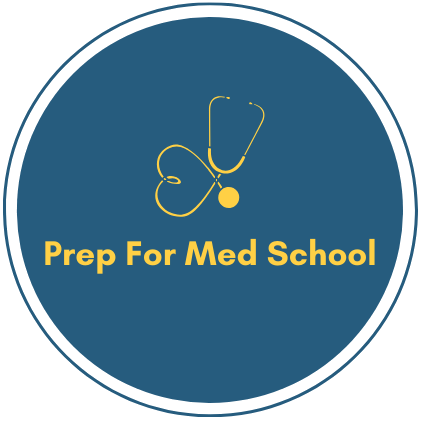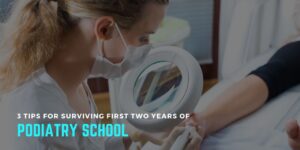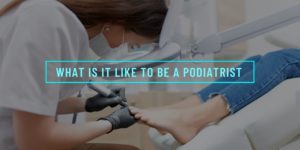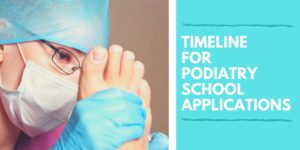A podiatrist is someone who treats these diseases. Popular ailments podiatrists treat include bone deformities, vascular cases, neurological issues, or systemic diseases.
A diverse curriculum in the classroom and clinic will train the podiatrist.
Podiatry school is a lot like MD/DO medical school. You do four years of education that include clinicals. After, you attend a 3-year residency program after graduation, with an option to do a fellowship.
Your training will include surgery, dermatology cases, diabetic foot care, and correcting biomechanical abnormalities on patients.
The patient population that a podiatrist sees is broad. From active professional athletes, to pediatrics, and even geriatrics with little ambulatory ability.
Getting Into Podiatry School
To become a podiatrist, you must complete a minimum of three years or 90 semester hours of college credit at an accredited institution. Although a bachelor’s degree is not required, over 97% of students entering podiatry schools have one. Within those 90 credit hours, some of those courses must be for podiatry school prerequisites. These prerequisites include classes in chemistry, biology, and physics—the same as any other pre-Medical prerequisites.
You will have to maintain a relatively high GPA and obtain an above-average score on your MCAT to gain admission into podiatry school. The average GPA for matriculated podiatry students from the years 2015-2019 is 3.3 with at least a 3.1 science GPA. Similarly, your MCAT scores must be competitive- the average MCAT score that has been accepted is 495. Both GPA and MCAT score averages have been rising with more capable students applying each year.
Compare to MD/DO matriculants, podiatry students do have lower incoming GPA/MCAT scores. The average GPA and MCAT for allopathic school matriculants is 3.72 and 511.5 respectively. The average GPA and MCAT for osteopathic school matriculants is 3.54 and 503.
Once accepted into a podiatric medical school you will go through 4 years of schooling with clinic. Upon graduation you will attend a surgery-based residency program of your choosing.
What is the Difference Between Podiatry School and Allopathic/Osteopathic Medical School?
The biggest difference is that you are entering podiatry school knowing what area of the body you will be specializing in.
The podiatry curriculum is virtually identical to allopathic/osteopathic schools. But, there is extra coursework to emphasize the specialty.
Podiatric medical schools may also not require certain clinical rotations such as OB/GYN rotation. However, this is sometimes completed in residency.
Full body function and pathology are part of the curriculum because podiatric students will rotate through every specialty in residency. You will see podiatry students and residents intubate patients, do emergency suture, place in IV lines, assist in a code, and even give chest compressions.
Residency and practice as a podiatrist is different than other specialties because of the patient range. Podiatrists are able to split their time as much as they would like between the clinic and the operating room. Some podiatrists do as little as one day of surgery per week, and others may do surgery every day. The autonomy a podiatrist has with their practice is what separates them from other specialties.
So now that you know what podiatry is all about, let’s take a look at what podiatry school and post-graduate looks like.
The following is a layout of how every year at most podiatry schools go as well as some anecdotes to give you a feel of how life as as a podiatric medical student.
One key element to notice is that podiatric medical schools are broken down into three semesters each year, this is in an effort to include specialty courses along with standard medical education.
Year One
Entry into podiatric medical school is an overwhelming experience, but it is nothing that you won’t be able to handle. The adage of “undergraduate is drinking from water bottle and medical school is like drinking from a fire hose” will make sense early on. But that’s not to say that the process is impossible. The one truth of the process is that the work does not become easier, you become better.
Fall Semester
You will enter taking the foundational courses: Gross Anatomy with Lab, Histology with Lab, Introduction to Podiatric Medicine, Biochemistry, and some statistical course. These courses are a staple of the first year as they will be the foundation that every other course will build on top of.
Besides the course work you’ll become acclimated to life in medical school. You’ll have social events the school will host, opportunities in research, academic clubs to join, and you may even have a bit of fun with your classmates. You’ll see, some of your classmates will become your very best friends.
Spring Semester
The courses will consist of Lower Extremity Anatomy with Lab, Neuroanatomy with Lab, Physiology with Lab, and Biochemistry II. This is one of the more difficult semesters, not because the courses are difficult, but rather because you are not be used to working at such a demanding pace.
The courses during this time are not only fast-paced, but it is dense material so you will absolutely be challenged. But after this semester you will move into more specialized material that allows you to feel and think more like a physician.
Summer Semester
The most dreaded semester of podiatry school! Unfortunately, in order to fit all the courses into the curriculum, semesters over summer are added. The courses that compromised this semester consisted of Microbiology, Radiology, Orthopedics, and Applied Lower Extremity. Unlike the other terms, in this term you will begin applying our knowledge into clinical scenarios. This is where you will begin thinking like a clinician
Year Two
Technically you become a second-year once you enter your first summer. This year is a favorite amongst students. You take interesting coursework, you’re able to volunteer in the clinic more, and at this point you’ve gotten the hang of the school-life balance. Most importantly, you will take your first Board Exam!
Fall Semester
This semester’s enrollment consists of Pathology, Pharmacology, Microbiology II, Podiatric Medicine, Podiatric Radiology, and Biomechanics. This semester will give you an insight into full body function and pathology. It will also hone you into thinking like a clinician.
You will begin connecting information from your courses thus far and you will begin relating how the foot and ankle plays a role in each of the pathologies that you have learned.
Spring Semester
For second year, the spring is a continuation of the fall. The courses are the same, but it will be the second part of each course or a clinical application of that course. Pathology II and Clinical Pharmacology are some courses to name a few.
In this semester you will continue to fine-tune your ability to think like a physician and you will integrate podiatry more and more into diagnoses and treatment options.
Summer Semester
The most important part of this summer is to study for boards. The American Podiatric Medical Licensing Exam (APMLE) Part I is the first of three licensing exams, or boards, that you will take during your tutelage. The boards are a measure of didactic and clinical competency that are taken in order to eventually grant you full licensure.
Podiatry boards are almost identical to MD/DO boards with our Part I being based on didactic work. Part II is split into a clinical exam and a written exam. Finally, Part III is taken after graduation during residency in order to fully obtain your licensure.
To assist with boards studying, schools will lighten the course load. Going from an average of 20 semester hours to usually 15-16. You will spend most of your summer days studying for boards and classes. It will all be worth it because after you pass Boards Part I- you are now a third-year and you’ll be off to the clinic!
Year Three
At Barry University the white coats are given after Boards Part I. This is known as the “Right of Passage” ceremony. At other schools you may get your white coat before you begin school! Not only that, but this is also when you begin your journey in the clinic.
Fall Semester
Your courses will concentrate on clinical presentations and treatments. Most schools will have you in Podiatric Surgery, Dermatology, a Vascular course, and continuing Podiatric Medical Course.
For Barry University, these courses take place on Monday and Tuesday. Clinical rotations take place the rest of the week. The rotations are 2 or 4 weeks long depending on the specialty. You will rotate through the ER, Anesthesia, Vascular Medicine, General Surgery, and you will be in many podiatric specialty rotations.
Spring Semester
The classes in this semester are either continuation of courses from the previous semester such as Podiatric Surgery II, or they will be different medical specialty courses such as Psychiatry. This semester is to continue to teach you about podiatry, and also to reinforce your knowledge on various specialties.
During this semester you will also begin to apply to your desired externship locations for fourth year. Externships are month-long rotations at different podiatric residency hospitals where you will work with the podiatric team. This is all in hopes to apply to your externship locations as potential residencies you may attend.
During 3rd year you will also choose dates for when you will be taking Boards Part II. The Part II consists of two parts- a clinical portion and a written examination.
Year Four
Summer and Fall Semester
This is the beginning of your externship year. Summer semester was omitted in the previous section because the summer of your 3rd year is when you begin your externship rotations.
These externships locations are of your choosing- most students choose these rotations based on location, case load, variety of practice (clinic versus surgery), and a myriad of other reasons. The one thing to keep in mind is to select programs you want to attend and where you think you will most benefit from going to. After all, one of these externship locations may very well become your Residency.
In the medical community these externships are referred to as “month-long interviews.” This is because during your time at these locations not only are you looking for a suitable match for yourself- but the residency programs are also looking for viable candidates to fill their residency positions.
The most important thing to remember about externships is work hard, absorb as much knowledge as you can, and above all be yourself!
Another thing to keep in mind is that during your 4th year you will also be taking your Boards Part II exams. The clinical part is conducted in Philadelphia- this is the one that you will schedule on your own. During this part of the boards you are graded based on your interactions with 12 different patients- all of whom you will have to diagnose and treat. The written part of boards will be at an announced time, usually in the beginning of January, that you will be able to take at most Prometric testing locations.
Spring Semester
Now that boards and externships are over you will return to your podiatric medical school in order to complete clinical hours in your school’s affiliated clinics.
Your time back will be short-lived, however, because you will be flying off to Dallas, Texas for residency interviews! The Residency programs are completely centralized meaning that instead of flying to various residency locations to undergo interviews- students and residency programs will all meet in Dallas in order to conduct the interviews.
The interview will vary based on your desired program. But with most you will have an academic portion to showcase your podiatric medical knowledge, followed by a social interview where the program gets to know a little more about who you are. Following this initial interview, you will be invited to a “call-back” which is an informal social meeting after interview hours are complete.
After interviews, you will fly back to your school to finish up your last semester and graduate!
Residency and Fellowship
The most recent placement reporting can be viewed here, and they are remarkable. Placement has been nearly 100% for this past year. That means anyone who was searching for a residency program was able to get one. Podiatric Residency is a 3-4-year surgery based program where you will be in the clinic, OR, and hospital.
During your time in residency you will complete surgeries of the foot, ankle, and leg to complete your numbers and graduate.
After graduating residency you will have the option to apply to and attend a fellowship. These fellowships are 1-2-year programs that will continue to specialize your skills. There are fellowships for surgery, sports medicine, and even wound care.
As you can see, the road you will embark on is a tedious one- but the end result is nothing short of astounding. Continue your research into podiatry, shadow a podiatrist, and see if this is the option for you. You may be surprised by the things you find and see, and who knows? Maybe one day you will begin your training to become a podiatrist as well.






